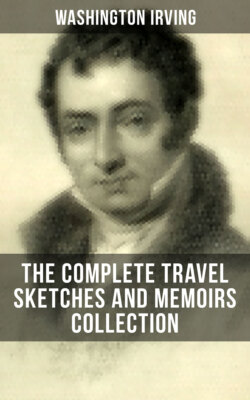Читать книгу Washington Irving: The Complete Travel Sketches and Memoirs Collection - Washington Irving - Страница 28
На сайте Литреса книга снята с продажи.
THE HOUSE OF THE WEATHERCOCK.
ОглавлениеTable of Contents
On the brow of the lofty hill of the Albaycin, the highest part of Granada, and which rises from the narrow valley of the Darro, directly opposite to the Alhambra, stands all that is left of what was once a royal palace of the Moors. it has, in fact, fallen into such obscurity, that it cost me much trouble to find it; though aided in my researches, by the sagacious and all-knowing Mateo Ximenes. This edifice has borne for centuries the name of “The House of the Weathercock” (La Casa del Gallo de Viento), from a bronze figure on one of its turrets, in ancient times, of a warrior on horseback, and turning with every breeze. This weathercock was considered by the Moslems of Granada a portentous talisman. According to some traditions, it bore the following Arabic inscription:
Calet et Bedici Aben Habuz, Quidat ehahet Lindabuz.
Which has been rendered into Spanish:
Dice el sabio Aben Habuz, Que asi se defiende el Andaluz.
And into English:
In this way, says, Aben Habuz the wise, Andaluz guards against surprise.
This Aben Habuz, according to some of the old Moorish chronicles, was a captain in the invading army of Taric, one of the conquerors of Spain, who left him as Alcayde of Granada. He is supposed to have intended this effigy as a perpetual warning to the Moslems of Andaluz, that, surrounded by foes, their safety depended upon their being always on their guard and ready for the field.
Others, among whom is the Christian historian Marmol, affirms “Badis Aben Habus” to have been a Moorish sultan of Granada, and that the weathercock was intended as a perpetual admonition of the instability of Moslem power, bearing the following words in Arabic:
“Thus Ibn Habus al Badise predicts Andalus shall one day vanish and pass away.”
Another version of this portentous inscription is given by a Moslem historian, on the authority of Sidi Hasan, a faquir who flourished about the time of Ferdinand and Isabella, and who was present at the taking down of the weathercock, when the old Kassaba was undergoing repairs.
“I saw it,” says the venerable faquir, “with my own eyes; it was of a heptagonal shape, and had the following inscription in verse:
The palace at fair Granada presents a talisman.
The horseman, though a solid body, turns with every wind.
This to a wise man reveals a mystery: In a little while comes a calamity to ruin both the palace and its owner.”
In effect it was not long after this meddling with the portentous weathercock that the following event occurred. As old Muley Abul Hassan, the king of Granada, was seated under a sumptuous pavilion, reviewing his troops who paraded before him in armor of polished steel, and gorgeous silken robes, mounted on fleet steeds, and equipped with swords, spears and shields, embossed with gold and silver; suddenly a tempest was seen hurrying from the southwest. In a little while, black clouds overshadowed the heavens and burst forth with a deluge of rain. Torrents came roaring down from the mountains, bringing with them rocks and trees; the Darro overflowed its banks; mills were swept away; bridges destroyed, gardens laid waste; the inundation rushed into the city, undermining houses, drowning their inhabitants, and overflowing even the square of the Great Mosque. The people rushed in affright to the mosques to implore the mercy of Allah, regarding this uproar of the elements as the harbinger of dreadful calamities; and, indeed, according to the Arabian historian, Al Makkari, it was but a type and prelude of the direful war which ended in the downfall of the Moslem kingdom of Granada.
I have thus given historic authorities, sufficient to show the portentous mysteries connected with the House of the Weathercock, and its talismanic horseman.
I now proceed to relate still more surprising things about Aben Habuz and his palace; for the truth of which, should any doubt be entertained, I refer the dubious reader to Mateo Ximenes and his fellow-historiographers of the Alhambra.
